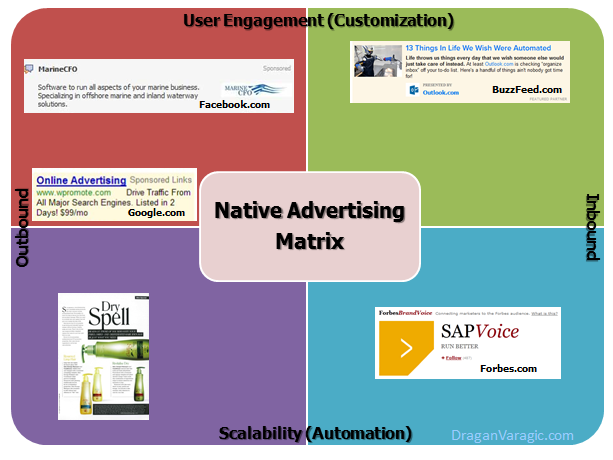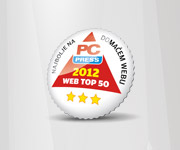There are many synonyms surrounding the buzz term Native Advertising, and the result of that fact is the divide about the purpose and the role of Native Ads, even in the established organization like IAB. Evidently, there is a luck of precise definition what Native Advertising is, and the problem is in the different perspectives of the Native Advertising stakeholders:
- Native advertising are Advertorials.
- Native Advertising are Sponsored Texts.
- Native Advertising are Google AdWords, Facebook SocialAds, Promoted Tweets, etc.
- Native Advertising is Branded Content.
The main problem surrounding Native Advertising is its inbound nature, opposed to a pure advertising (outbound) perspective.
Native Advertising should be:
- Really interesting/usable content addressed to the target audience (not like classic Sponsored Texts, nor classic Advertorials),
- Native Advertising content is created in the context of the hosted media news editorial guidelines (opposed to “one size fits all” Ad formats),
- Target audience should be engaged around Native Advertising content (Social Media component)
Native Advertising Matrix
In order to clarify the difference between different types of present Native Advertising manifestations, here is the proposition of the different Native Advertising types:
There are four types of native advertising “formats” proposed (or just explained):
- Effective Contextual Advertising formats – Not all contextual advertising is interesting, nor engaging, even some people will say that not all contextual advertising is contextual (in the context of the surrounded content). For some of engaging and effective Contextual Advertising efforts can be said that they are Native Advertising.
- Advertorial is legacy ad format from newspapers and magazines, it can be easily copied on the news web sites, but it is not Native Advertising! Advertorials are not engaging, and in the most of cases those creative works are not very interesting!
- Sponsored Texts can be created by an organization to be interesting and in the context of a hosted media editorial guidelines (media where the sponsored text is put), but there is the problem that not all organizations have resources (people, journalists) to create interesting and engaging sponsored content. Examples like Forbes Brand Voice prove that Sponsored Text can be feasible revenue stream for media.
- It can be said that Sponsored Texts and Branded Content are very similar terms, but Branded Content can be used to describe the difference between the Forbes Native Advertising model and the model of BuzzFeed. BuzzFeed’s journalists help their clients to produce more effective (more interesting) content, which is more close to other BuzzFeed’s content they curate or create. Branded Content as the Native Advertising type can be used for the explanation of the difference when news media directly participates in the creation of Native Advertising content.
There is no scalability, nor automation in Native Advertising!
One of the main issues in online advertising industry is scalability of ad formats, and IAB successfully manages the standardization in this field. But, there is a problem with the standardization of Native Ad formats, because this type of advertising is not so scalable like other (more outbound) advertising formats. There is no manageable number of Native Ad formats, there is many ways how to produce Native Ad content, etc.
You can put same advertorial or sponsored text on a thousands of websites, or even you can put Google Ad on their content network, but it is not Native Advertising!
The people who are in classic online advertising business (outbound) generally are not very receptive to inbound components of Native Advertising. The more time is needed for a lot of people in advertising industry to accept the fact that there are blurring lines in Marketing (Advertising) and PR (Publicity) activities, in the time of Social Media.
Social Media development enables the concept of Native Advertising, and media like BuzzFeed.com use “Social Media Boost” inline with their web site audience to get the better results for Native advertisers. In this concept of social media use for Native Advertising boost, automation and scalability are not welcomed – there is no good social media strategy with engagement automation, nor scalability of the messages sent through Native Advertising as the communication channel.
I would like to hear/read your thoughts about proposed matrix.
Native Ad Types Proposition: Native Advertising Matrix,




